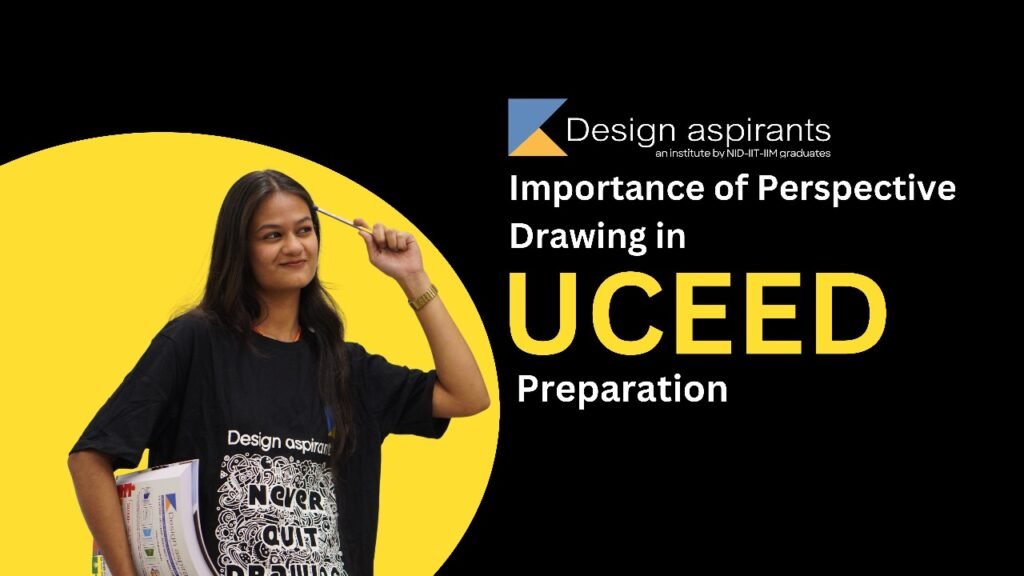
UCEED Preparation requires a strong foundation in design principles, creativity, problem-solving, and visual representation. Among the various skills tested, perspective drawing holds significant importance. It is a fundamental aspect of visual communication that helps students represent objects, spaces, and environments with accuracy and depth.
In UCEED Preparation, mastering perspective drawing enables candidates to enhance their spatial awareness, proportion control, and depth perception, which are essential for sketching-based questions. This blog explores the role of perspective drawing in UCEED Preparation, its key techniques, and strategies to improve perspective drawing skills effectively.
What is Perspective Drawing?
Perspective drawing is a technique used to represent three-dimensional objects on a two-dimensional surface while maintaining depth and proportion. It allows designers to create realistic representations of objects and environments, making their sketches visually accurate and convincing.
There are different types of perspective drawing:
- One-Point Perspective – Used when objects are directly facing the viewer, converging towards a single vanishing point.
- Two-Point Perspective – Commonly used for drawing objects at an angle, with two vanishing points.
- Three-Point Perspective – Typically used for extreme angles, such as bird’s-eye or worm’s-eye views, incorporating three vanishing points.
Why is Perspective Drawing Important in UCEED Preparation?
1. Enhances Visual Representation Skills
UCEED Preparation involves creating sketches that depict objects, buildings, or environments with proper proportions. Perspective drawing helps in achieving realistic visual compositions with depth and accuracy.
2. Improves Spatial Awareness
A strong understanding of perspective enables candidates to analyze objects in a three-dimensional space. This skill is crucial for answering design-related questions that involve depth, form, and proportion.
3. Strengthens Proportion and Composition Control
One of the key aspects of UCEED Preparation is learning how to balance objects within a frame. Perspective drawing ensures that sketches maintain the correct proportions and alignment.
4. Helps in Rapid Sketching for UCEED Exam
During the UCEED exam, time is a crucial factor. Mastering perspective drawing allows students to quickly sketch complex structures, environments, and product designs with precision and clarity.
5. Essential for Problem-Solving and Visualization
UCEED often includes visual reasoning and analytical ability tests. Perspective drawing strengthens a student’s ability to visualize and reconstruct objects based on given information.
How to Improve Perspective Drawing for UCEED Preparation?
1. Understand the Basics of Vanishing Points
Learning about horizon lines, vanishing points, and depth cues is essential for perspective drawing. Students should practice sketching simple objects using one-point, two-point, and three-point perspective techniques.
2. Practice Drawing from Real-Life Observations
Observing buildings, streets, and interiors and replicating them on paper helps in developing better spatial understanding and accuracy in perspective drawing.
3. Work on Freehand Perspective Sketching
Since UCEED requires quick ideation, students must practice freehand sketching without relying on rulers. This improves their speed and confidence in drawing complex forms under exam conditions.
4. Analyze Perspective in Architectural and Product Design
Studying architectural drawings, product sketches, and industrial design blueprints helps in understanding how professional designers apply perspective techniques in real-world applications.
5. Solve Previous Year UCEED Papers with a Focus on Perspective Drawing
Reviewing previous year UCEED papers helps in identifying the types of perspective-based questions that appear in the exam. Regular practice of these questions improves accuracy and confidence.
Common Mistakes in Perspective Drawing and How to Avoid Them
1. Misplacing the Vanishing Points
- Mistake: Incorrect placement of vanishing points leads to distorted sketches.
- Solution: Always start by marking the horizon line and vanishing points before sketching objects.
2. Uneven Scaling of Objects
- Mistake: Inconsistent scaling results in objects appearing disproportionate.
- Solution: Use guidelines and reference lines to maintain proper proportions.
3. Rigid and Overly Mechanical Sketches
- Mistake: Using excessive grid lines makes drawings appear stiff.
- Solution: Practice freehand sketching to develop a more natural approach to perspective.
4. Lack of Depth and Overlapping Elements
- Mistake: Flat-looking sketches due to missing depth cues.
- Solution: Add overlapping elements, shading, and varying line thickness to create a sense of depth.
Conclusion
Perspective drawing is an integral part of UCEED Preparation, helping students visualize, structure, and present their ideas effectively. Mastering perspective techniques enhances spatial awareness, proportion control, and rapid sketching abilities, which are essential for excelling in UCEED.
To improve perspective drawing skills for UCEED Preparation, students should:
- Practice daily sketching using different perspective techniques.
- Observe real-world structures and draw them from various angles.
- Analyze perspective in product and architectural designs.
- Solve previous year UCEED questions with a focus on spatial representation.
By integrating perspective drawing into their UCEED Preparation, candidates can significantly enhance their visual representation skills and improve their performance in the exam.
